The Best Privacy Hedges: Shrubs and Trees for Privacy (With Pictures)

Privacy hedges provide a natural evergreen barrier to screen your yard from prying neighbors, wind, and noise. Not only do hedge bushes and shrubs protect your privacy, but they also add aesthetic value to any type of garden.
The best privacy hedges are:
- Cherry laurel (Prunus laurocerasus)—Excellent flowering evergreen privacy shrub with large dark green leaves that are perfect for windbreaks and privacy screens in your yard.
- American arborvitae (Thuja occidentalis)—This conifer is a popular tree hedge for keeping yards secluded. This tree has dense, soft foliage and it’s easy to prune if you want to create a shaped privacy hedge for your yard.
- Box Hedging (Buxus sempervirens)—Great evergreen hedging shrub that has lush evergreen foliage and compact growth. This hardy privacy shrub is one of the most popular shrubs for privacy screen and living fence.
- Common Holly bushes (Ilex aquifolium)— Thorny evergreen shrub that makes an excellent privacy hedge. This defensive hedge has spiky evergreen leaves that helps deter intruders and animals.
- Common privet (Ligustrum vulgare)—A fast-growing semi-evergreen privacy bush that is one of the most popular shrubs for privacy hedge and ornamental garden plants.
What Makes a Great Privacy Hedge?
Evergreen bushes, shrubs, or hedging trees are the best plants to grow for a privacy screen around your yard. Privacy hedges should consist of fast-growing plants that grow to the height you desire. Ideally, the perfect privacy hedge creates a natural barrier of dense foliage to keep out noise, wind, and curious looks from nosy neighbors.
How to Select Plants for Privacy Hedge
Choose evergreen plants for year-round protection from the elements. Many types of conifers make for suitable privacy screens. Some can grow very tall, but others are more compact cultivars. Many kinds of flowering evergreen bushes also keep their foliage throughout the year—just perfect for adding color to your garden.
How to Maintain a Privacy Hedge
The best privacy bushes should be low-maintenance hedge plants. Many evergreen trees grow straight and tall and only need pruning to control their height and spread. Some of the popular hedge bushes are easy to shape and prune into natural privacy screens. One such example is the appropriately named boxwood hedge, which easily maintains a square shape.
Popular Shrubs for Privacy Hedges (With Pictures and Names)
Many types of garden shrubs are great bushes for privacy screening to create a secluded garden, protected from prying eyes. Their year-long foliage and beautiful flowers create attractive borders in your yard.
Cherry Laurel (Prunus laurocerasus) — Excellent Privacy Hedge
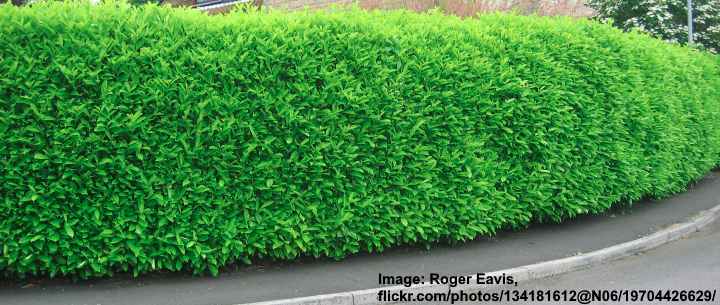
Cherry Laurel is a great fast growing evergreen shrub used as a privacy hedge and as a living privacy screen
Also called the English laurel, this vigorous evergreen shrub is ideal for privacy screens and useful privacy hedges. This bushy hedging plant keeps its glossy green foliage all year long. The fast-growing shrubby plant has dense growth and thrives in full sun or partial shade. Although these bushes can reach 15 to 30 ft. (4 – 12 m) high, regular pruning keeps growth to a manageable size.
You can plant cherry laurel as a flowering privacy screen to brighten up your yard. Creamy-white flowers appear in mid-summer that give off a fruity fragrance.
Photinia ‘Red Robin’ (Photinia x fraseri ‘Red Robin’)
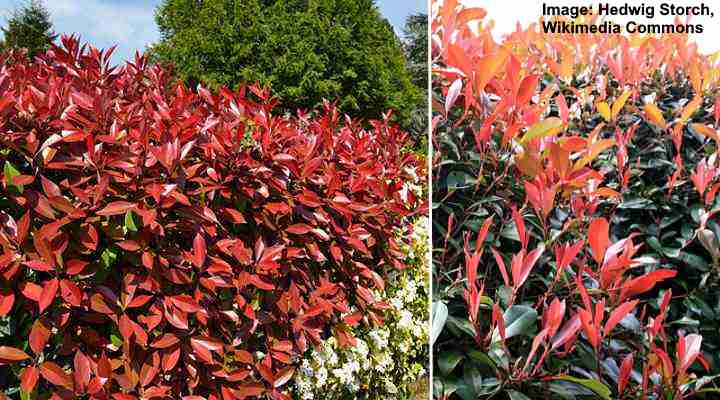
Grow Photinia ‘Red Robin’ privacy bushes for their beautiful red foliage
The ‘Red Robin’ cultivar is an evergreen bushy plant that is perfect for creating a colorful hedgerow. The shrub has dense growth to create privacy. When growing as a hedge, it can provide enough concealment in a garden or be a useful living fence. Trim the shrubs every spring and summer to create a formal hedge.
This Photinia produces stunning vivid red foliage in spring that gradually turns to dark green. White delicate flowers and red berries just add to the visual interest that this privacy shrub offers. You can expect growth to be about 1 foot (30 cm) a year when growing in full sun or partial shade.
Laurustinus (Viburnum tinus) — Flowering Privacy Screen
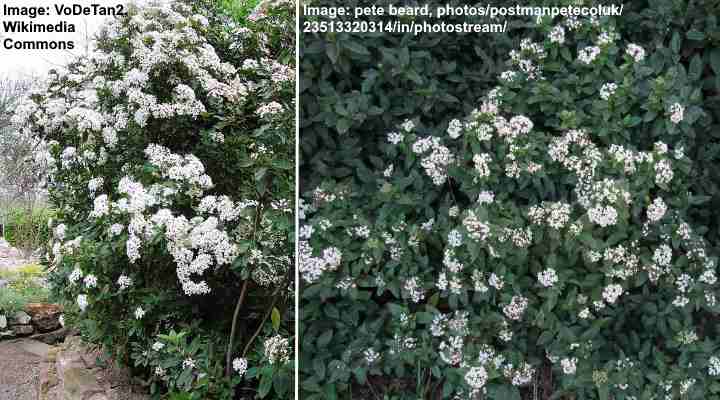
The easy to grow Laurustinus can create a stunning flowering privacy living fence
Perfect for colorful hedges or living privacy screens, the Viburnum tinus bush has dense evergreen foliage. The shiny dark green leathery leaves and striking flower clusters add visual beauty to your garden. The vigorous privacy shrub has fast growth and will eventually reach 8 ft. (2.4 m) tall with a rounded spread of 6 ft. (1.8 m).
Plant Laurustinus bushes as hedges or screens, or you can create a colorful shrub border hedge. The clusters of flowers bloom in winter to brighten up yards in late in the year. The only maintenance this easy-to-grow bush requires is some pruning to keep it growing as a formal, romantic hedge.
Box Hedging (Buxus sempervirens) — Low-Maintenance Privacy Hedging
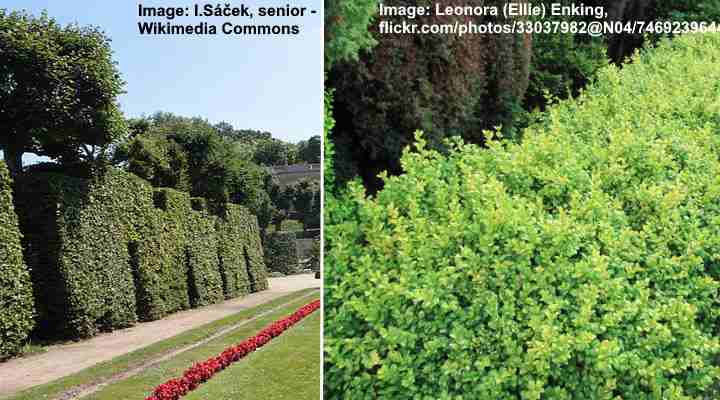
Box hedging is a popular border shrub in formal gardens because it’s easy to shape and prune into natural privacy screen
One of the best shrubs for privacy is the compact boxwood. Its dense, neat growth, and soft, lush foliage, provide the privacy and security you need from a living screen. Species of boxwood are easy to prune and shape and, as the name suggests, can be pruned into a box-shaped hedge.
Depending on the cultivar, boxwood privacy hedges grow to between 3 and 30 ft. (1 – 9 m) tall. You can plant these slow-growing shrubs as hedging in most types of soil and part shade. Boxwood is a popular hedging plant for formal gardens, low formal hedges, or privacy screens in small gardens.
For added beauty in a garden, some people grow rose of Sharon plants in a boxwood hedge. The hibiscus plant produces showy summer flowers, and the boxwood provides winter privacy.
Firethorn (Pyracantha)
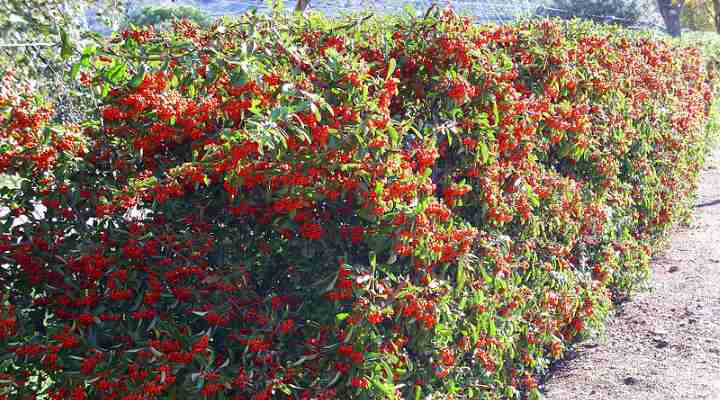
Firethorn shrubs create a decorative privacy screen with their ornamental red berries
Firethorn is an excellent privacy shrub to create dense living screens where security is essential. The bushes grow to create attractive glossy foliage with thorny spikes. With pruning, you can easily trim bushes into useful hedges. Or, these border bushes grow along fences or walls to increase security.
The attractive features of these blooming privacy shrubs are their flowers and berries. Clusters of white flowers grace the spiky hedge foliage in spring and summer before turning into bright red or orange berries in the fall and winter. Using firethorn bushes as a barrier hedge will help to ensure that unwanted guests are kept out.
Holly (Ilex) – Security and Privacy Hedge
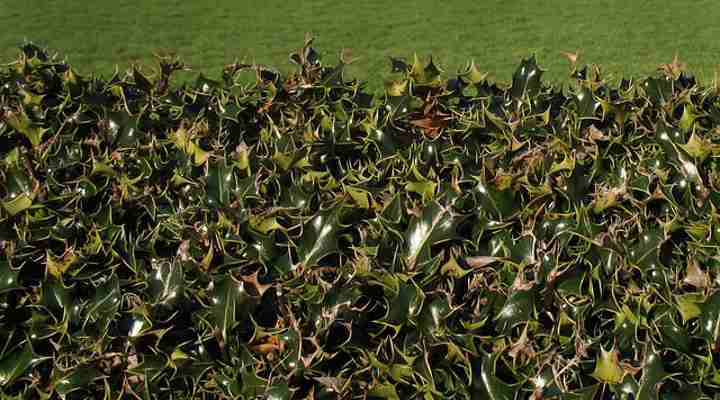
Holly bushes are common low-maintenance plants for living fences. This thorny evergreen shrub has leaves with spiked edges which make it an excellent defensive shrub for landscaping
Species of common holly are another type of privacy shrub that has prickly foliage to increase security. Many types of evergreen holly are thorny shrubs that are easy to grow and require little maintenance once the hedgerow is established. These evergreen hedging plants have leaves with spiked edges that help keep trespassers out of your yard.
American Holly (Common Holly / English Holly) Ilex aquifolium ‘Alaska’
The ‘Alaska’ holly is especially well-suited plant to growing as a privacy hedge. It’s dense, yet slim growth creates narrow privacy hedges. The thorny leaf edges of this plant makes it an excellent defensive shrub to help keep trespassers out of your yard.
Another Ilex aquifollium that creates a showy privacy hedge is the ‘Hedgehog Holly.’ This defensive spiky shrub has variegated dark glossy green leaves with yellow edging. These holly species are easy to shape if you want a bright, formal privacy screen that keeps out intruders.
Dragon Lady Holly (Ilex × aquipernyi ‘Meschick’)
The ‘Dragon Lady’ is an evergreen holly bush with smooth green foliage and a dense growth habit. This species of holly is excellent for privacy hedges as it has upright, symmetrical growth in a narrow pyramid shape. Planted side by side, these holly bushes create a glossy hedgerow that stays green throughout the winter.
If you need a privacy screen with dense foliage, you should plant the ‘Meschick’ cultivar in a sunny location. Full shade causes the foliage to open out and become less dense.
Sky Pencil Holly (Ilex crenata ‘Sky Pencil’)
As its name suggests, this holly hedging plant has a narrow, erect growth that looks like a pencil reaching to the sky. These columnar tree-like plants have shiny foliage made up of small dark green leaves. The small shrubby columnar trees can grow to between 6 and 10 ft. (1.8 – 3 m) tall.
‘Sky Pencil’ hollies are common plants for using as hedges, privacy screens, or planting along walls or fences. One of the beauties about using these holly plants for screenings is that they require no maintenance to keep their shape. You just need to prune the tops to keep them at the desired height.
False Holly (Osmanthus heterophyllus)
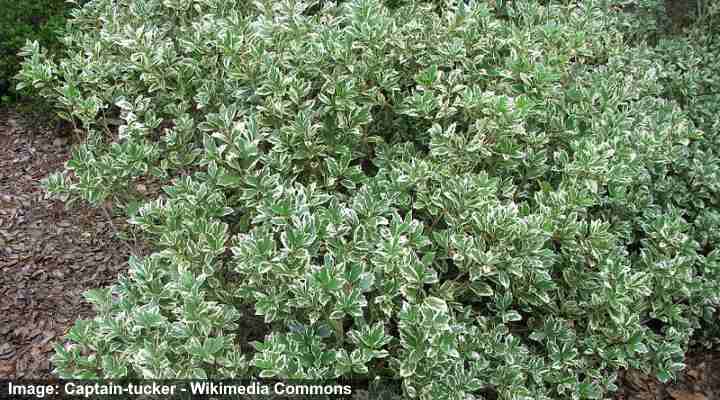
False hollies are fast growing privacy shrubs. In the picture: variegated false holly with green and white foliage
False holly plants have leaves that look like holly trees, but they are related to olive trees. The dense growth and lush evergreen foliage make false hollies one of the best shrubs for privacy. The hardy shrub is a drought-resistant plant and can grow in most conditions.
False hollies are suitable if you want a fast-growing, flowering privacy screen in your yard. The low-maintenance shrub produces a multitude of fragrant white flowers in the fall and winter.
If you are looking for a privacy screen to brighten a garden, choose the colorful Osmanthus heterophyllous ‘Variegatus.’ The beautiful green and white spiny leaves are perfect for bright hedges, living screens, or border bushes.
Japanese Spindle (Euonymus japonicus)

The dense foliage of Japanese spindle is fantastic to create a border privacy hedge
The Japanese spindle evergreen shrub has small, brightly-colored green leaves that form dense foliage. The versatile garden plant is suitable for planting side by side to create cheerful privacy hedges. They are easy to grow wherever you need to add some privacy in your front or back yard.
Japanese spindle includes many cultivars, some with variegated or yellow leaves. A mature hedgerow will grow to between 6.5 ft. – 26 ft. (2–8 m) tall. This shrub requires little maintenance to keep this hedge plant growing well in your garden.
Japanese Pittosporum (Pittosporum tobira)
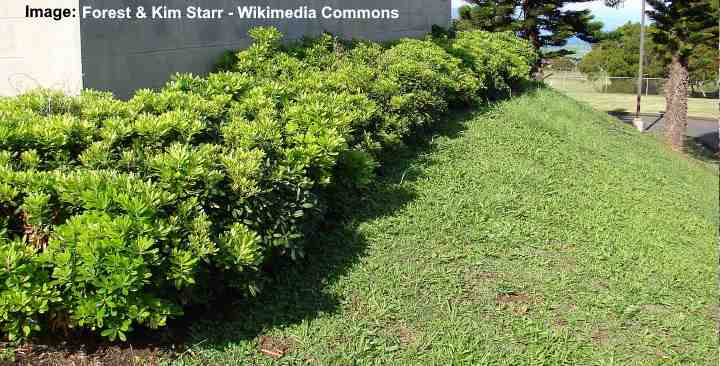
The fast growing Japanese Pittosporum privacy bushes include variegated cultivars for added interest and beauty
Also called the Australian laurel, mock orange, or Japanese cheesewood, this hedging plant has oval-shaped leaves and white flowers. The common name “mock orange” comes from the orange scent that the flowering hedge produces. This privacy bush is a fast grower that thrives in most soil types and part shade.
This popular hedge bush is suitable for pruning to create a smart, formal hedge that can reach 33 ft. (10 m) tall and broad spread, but it can also be trimmed into a hedge. To add color and interest to your garden, you can find variegated cultivars if you need a bright privacy hedge. Or, there are dwarf cultivars to choose from if you need a low-growing border hedge.
Chinese Fringe Flower (Loropetalum chinense)
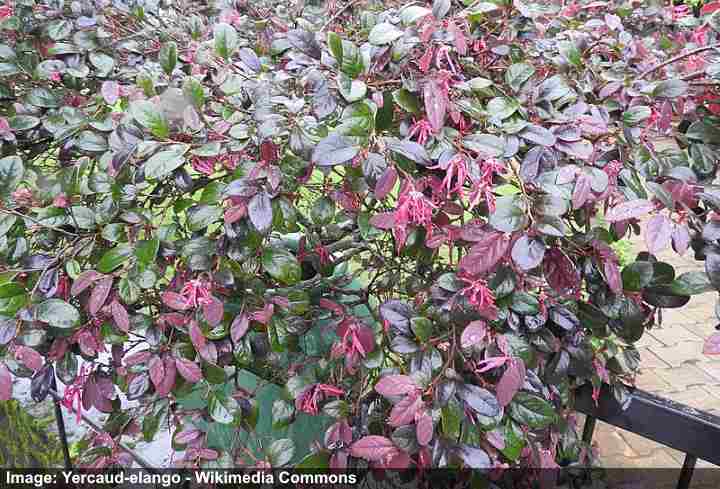
The attractive purple foliage of the Chinese Fringe Flower adds decorative element to your living fence
The Chinse Fringe Flower is one of the most stunning shrubs for privacy hedging due to its dark purple, almost black dense foliage. The bushy evergreen shrub has a neat, compact growth habit that keeps its color and leaves all year long. Striking pink flowers grow in early spring to add elegance to this lovely hedge.
Shrubs in the plant genus Loropetalum grow to around 5 ft. (1.5 m) tall. Once the hedging plant is established, only minimal pruning is required to keep its neat, formal shape. Grow as a hedge along entryways, as a medium sized privacy screen, or as a living fence.
Common Privet (Ligustrum vulgare) — Popular Privacy Hedges
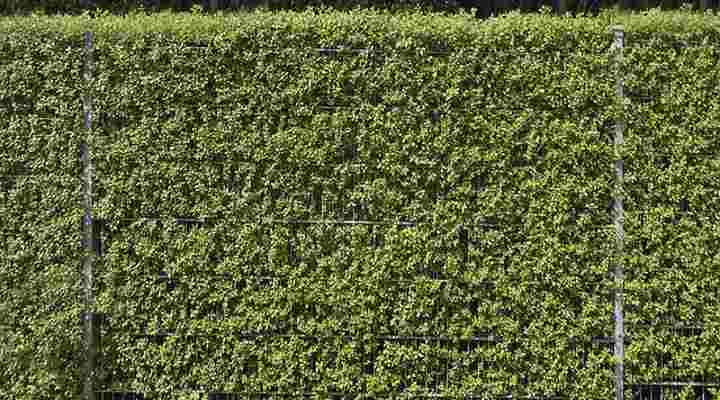
Choose the common privet shrub if you want a fast growing privacy screen
The common privet is one of the most popular types of shrubs used for privacy hedges. Its dense, compact growth and bright green, small leaves combine to create living fences that offer protection from the wind, noise, and nosy neighbors. Due to the fast-growing nature, a hedge can quickly grow in just a few seasons.
The beauty of using common privet shrubs for hedgerows is that they are easy to prune and shape. You can create a formal, box-type hedge that is up to 10 ft. (3 m) tall. Dainty white flowers appear in summer and give way to small black berries in winter. Depending on the climate and the variety, privet hedges can be evergreen, semi-evergreen, or deciduous.
Evergreen Indian Hawthorn (Rhaphiolepis indica)
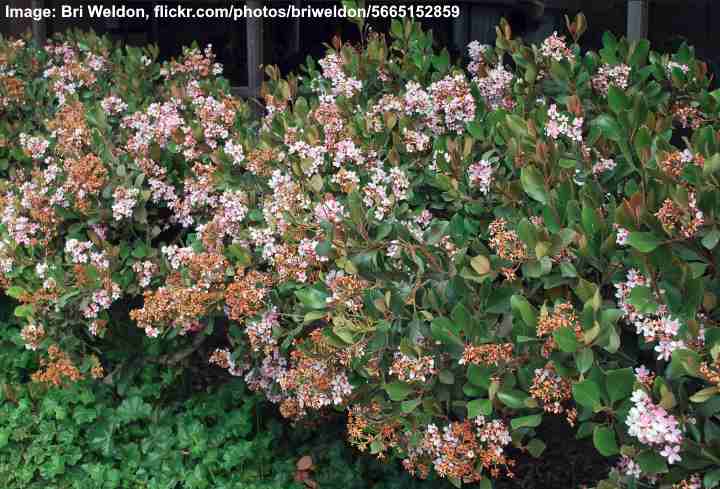
Indian Hawthorn shrubs can create attractive evergreen flowering privacy hedge in your garden
This small, compact shrub is ideal as a flowering privacy hedge. The Indian hawthorn has a rounded growing nature that creates an informal hedge along a wall or as a standalone privacy screen. The hedging hawthorn plant requires little maintenance to grow as a hedge. Every spring, the bushy hedge produces sweetly fragrant, white flowers.
The dense foliage growth will deter animals and intruders as well as not allowing snooping neighbors to peek through. This evergreen hedge also provides plenty of privacy even in winter when other deciduous plants have lost their leaves.
New Zealand broadleaf (Griselinia littoralis)
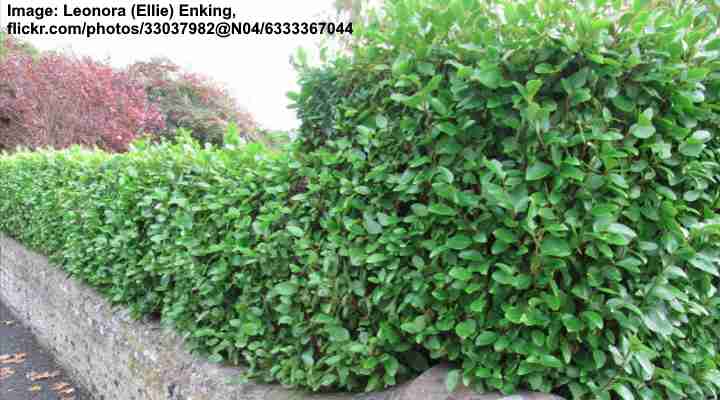
Griselinia littoralis is a hardy low-maintenance evergreen fast grwoing privacy bush
This hardy evergreen shrub native to New Zealand has all the features of the perfect privacy hedge. The hedge bush has dense, compact foliage that stays throughout the year, fast growth, and low-maintenance needs. The woody stems are also strong enough to offer protection from strong winds.
The Griselinia littoralis has excellent resistance to salt. Therefore, it is an excellent choice for growing privacy hedges in coastal regions or acting as a windbreak against strong sea breezes.
Anglo-Japanese Yew (Taxus x media ‘Hicksii’)
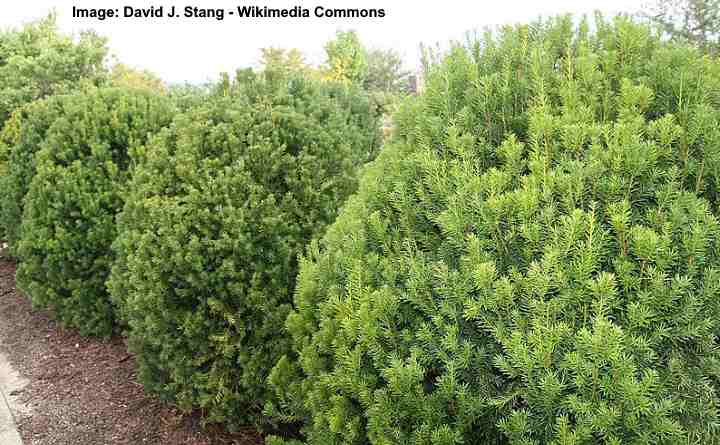
Yew ‘Hicksii’ privacy bushes can be pruned to create a formal hedge
Perfect for a box-type privacy hedge, this yew cultivar is a compact shrub that has shiny dark green needle leaves. The slow-growing shrub grows about 5” (12 cm) a year. However, you can prune this evergreen into a beautiful formal hedge that eventually grows up to 20 ft. (6 m) tall.
Popular Trees for Privacy Hedge (With Pictures and Names)
Many species of evergreen trees are also suitable for growing as a living privacy screen. Lots of conifers have soft, feathery foliage and dense, upright growth habit. Let’s look at a few types of trees that offer plenty of privacy for your yard.
American Arborvitae (Thuja occidentalis)
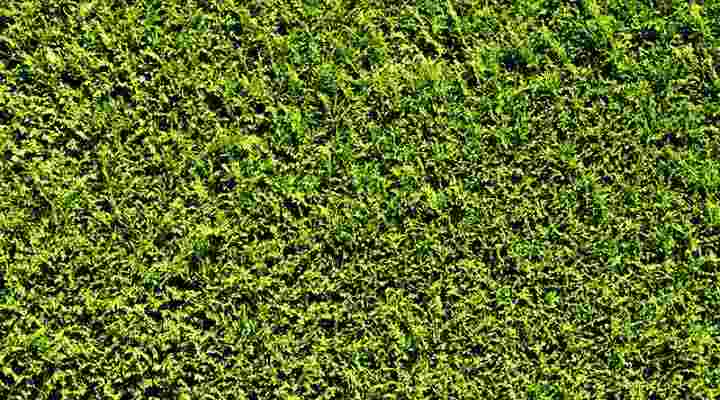
Arborvitae (Thuja) species are very popular as privacy screens and hedges with many cultivars to choose from
Species of arborvitae are the most popular type of evergreen trees to use for privacy screens and hedges. Their upright, columnar growth and easy maintenance mean that the conifers are perfect for hedgerows. Trees in the genus Thuja are also fast-growing. So, in no time at all, you can have a privacy hedge a few feet high.
Here are a few species of arborvitae (Thuja) that are excellent for long, full hedgerows:
- Thuja occidentalis ‘Smaragd’—This American arborvitae is a semi-dwarf evergreen tree with a compact, narrow, upright growing habit. The emerald Thuja is one of the most popular arborvitae plants for hedges and borders.
- Thuja standishii x plicata ‘Green Giant’—A fast-growing conical-shaped tree that is excellent for privacy screens or hedges.
- Thuja occidentalis ‘Filips Magic Moment’—This golden-yellow evergreen tree with its erect, dense, columnar growth is perfect for bright, informal hedgerows.
Leyland Cypress (Cupressus x leylandii)
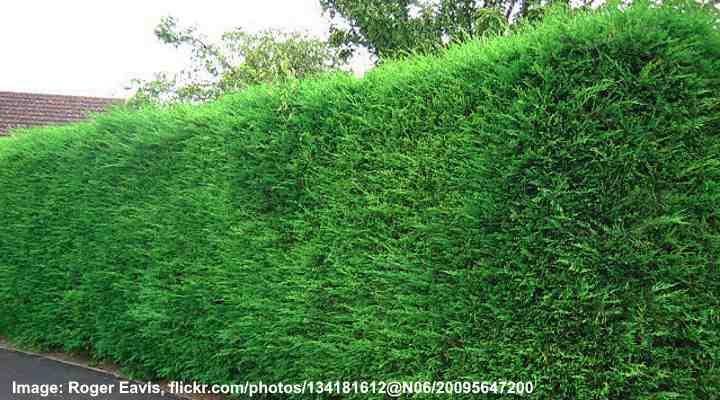
Leyland Cypress is a popular hedging tree – it’s a fast growing, dense evergreen tree hence it’s very commonly used as a privacy screen
This cypress cultivar has fast, dense growth that makes this an excellent hedging tree for year-long shelter, privacy, and protection. Most people choose this type of tree for its huge height. However regular pruning maintains its shape and height, and you can easily create a square boxed privacy hedge and sound barrier.
The Leyland cypress is a species of fast-growing coniferous tree that is one of the most popular hedging plants for privacy screens. When planted side by side, these evergreen privacy trees create a dense garden hedge which can be as short as 6 ft. (2 m) or as tall as 22 ft. (7 m).
Hornbeam (Carpinus betulus)
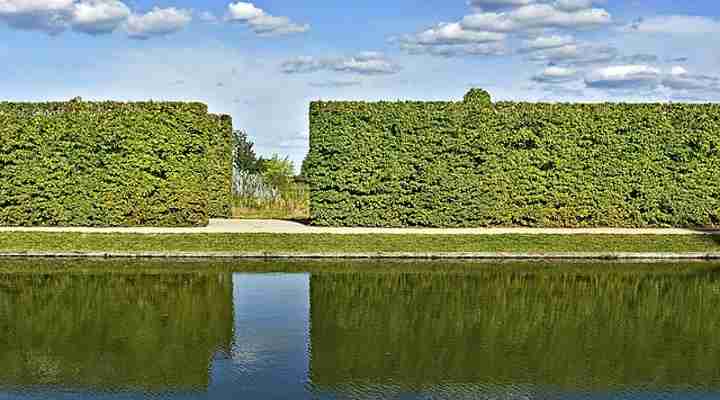
The fast growing Hornbeam can be pruned to create a formal dense privacy hedge
Common hornbeam trees are semi-evergreen. So, although they will lose some leaves in winter, the hedging plants still offer some privacy. During the growing season, hornbeam trees have thick, dense foliage to create the ultimate living privacy screen. The fast-growing trees will quickly reach heights of up to 13 ft. (4 m). Plant these privacy trees if you want to create a formal hedge.
Canadian Hemlock (Tsuga canadensis)
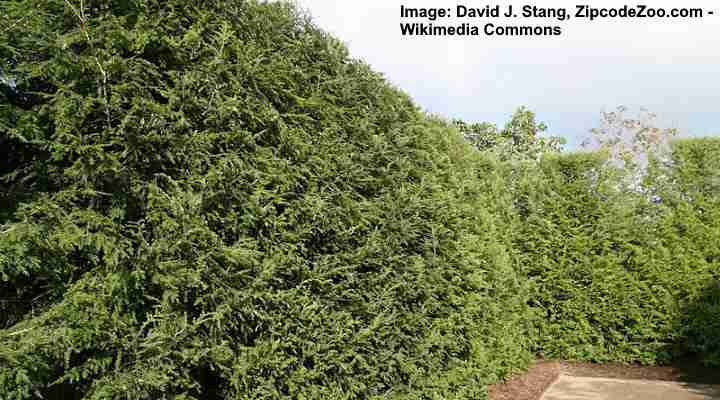
Canadian Hemlock creates fast growing dense living fence
Also called the Eastern Hemlock, this species of conifer has vigorous growth with a pyramidal shape. Growing side by side, these evergreen trees from a dense protective hedge that provides shelter from wind and noise. The bushy tree can easily be trimmed to create a stunning privacy hedge.
Discover the best privacy trees – fantastic privacy fence trees with their picture.
Related articles:
- 15 Small or Dwarf Evergreen Trees For Your Garden
- Types of Shrubs: 18 Different Types of Bushes to Grow in Your Yard
- The Best Privacy Trees: List of Great Privacy Fence Trees
